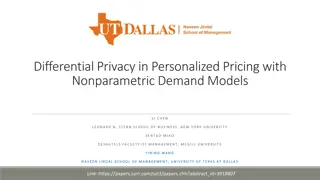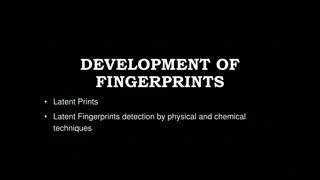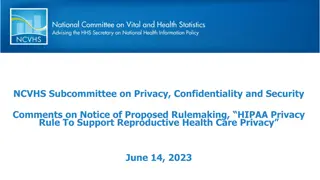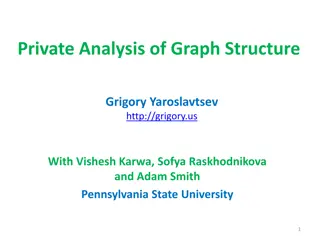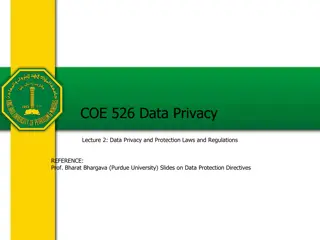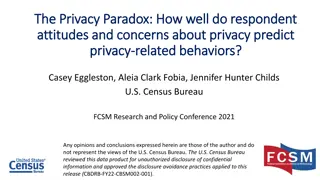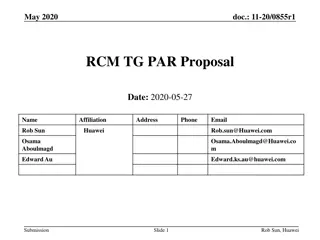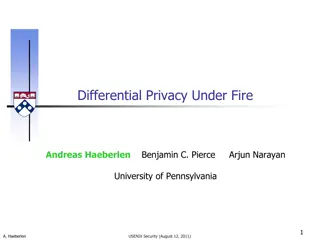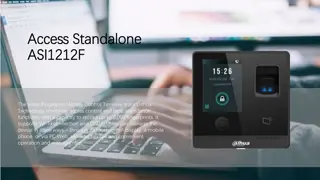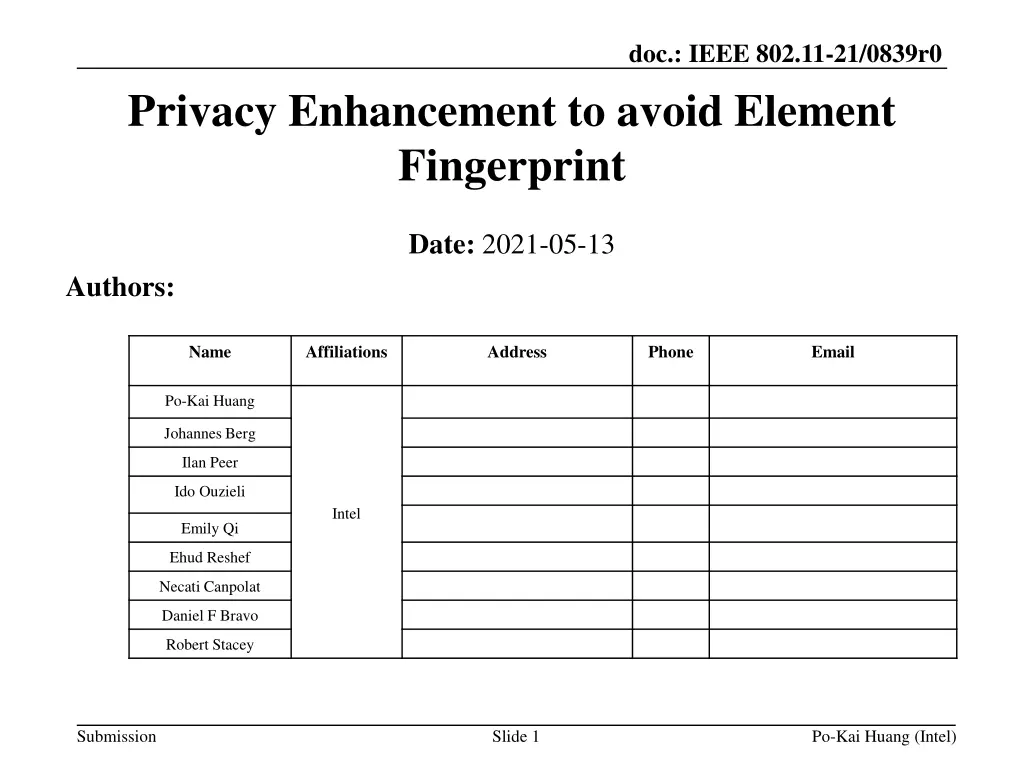
Privacy Enhancement in IEEE 802.11-21
Enhance privacy in IEEE 802.11-21 by avoiding element fingerprinting through the utilization of PMKID. The proposed method provides a solution to protect (re)association request/response frames without the need for asymmetric cryptography, ensuring secure communication. Various privacy enhancements and a flow to avoid PMKID tracking are discussed, offering insights into a standardized private limited connection for generating first-time PMKSA. Explore this presentation for valuable information on enhancing privacy in wireless communications.
Download Presentation

Please find below an Image/Link to download the presentation.
The content on the website is provided AS IS for your information and personal use only. It may not be sold, licensed, or shared on other websites without obtaining consent from the author. If you encounter any issues during the download, it is possible that the publisher has removed the file from their server.
You are allowed to download the files provided on this website for personal or commercial use, subject to the condition that they are used lawfully. All files are the property of their respective owners.
The content on the website is provided AS IS for your information and personal use only. It may not be sold, licensed, or shared on other websites without obtaining consent from the author.
E N D
Presentation Transcript
doc.: IEEE 802.11-21/0839r0 Privacy Enhancement to avoid Element Fingerprint Date: 2021-05-13 Authors: Name Affiliations Address Phone Email Po-Kai Huang Johannes Berg Ilan Peer Ido Ouzieli Intel Emily Qi Ehud Reshef Necati Canpolat Daniel F Bravo Robert Stacey Submission Slide 1 Po-Kai Huang (Intel)
doc.: IEEE 802.11-21/0839r0 Background Various privacy enhancements have been discussed PMKID [1] Password Identifier [2] fingerprint quasi-identifier [3-4], which is also called element fingerprint in [5] Proposal in [3] is more general and can protect the whole (re)association request/response frame, but it needs asymmetric crypto, where trusted public key distribution is hard [2] We demonstrate in this presentation that PMKID privacy enhancement can essentially be utilized to solve element fingerprint by protecting (re)association request/response frame without the need of asymmetric crypto Submission Slide 2 Po-Kai Huang (Intel)
doc.: IEEE 802.11-21/0839r0 Flow in [1] to avoid PMKID tracking User MAC address 1 Generate first-time PMKSA/PMK and PMKID1 Disconnect Use MAC address 2 STA AP Open Authentication STA generates another PMKID2 attaches to the same PMKSA of previous PMKID1 AP generates another PMKID2 attaches to the same PMKSA of previous PMKID1 Use PMKID1 to associate and avoid authentication to derive PMK again Disconnect Use MAC address 3 Open Authentication Use PMKID2 to associate and avoid authentication to derive PMK again Submission Slide 3 Po-Kai Huang (Intel)
doc.: IEEE 802.11-21/0839r0 Proposed Method First, develop a standardized private limited connection to generate first-time PMKSA using existing authentication/association procedure Only standardized capability/operation element with standardized indication needs to be included in frames (ex probe/authentication/association) required to generate first-time PMKSA Remove all the unnecessary elements that is not required to generate first-time PMKSA Can use any randomized MAC address User MAC address 1 Private limited connection to generate first-time PMKSA/PMK and PMKID1 STA AP Submission Slide 4 Po-Kai Huang (Intel)
doc.: IEEE 802.11-21/0839r0 Proposed Method First, develop a standardized private limited connection to generate first-time PMKSA using existing authentication/association procedure Second, change MAC address and use authentication exchange (ex open) with PMKID in authentication frame to identify PMK and derive a key Open authentication exchange can not be tracked Standard KDF method (ex KDF-Hash-Length (PMK, Label, Context)) to derive key early to protect following (re)association request/response User MAC address 1 Private limited connection to generate first-time PMKSA/PMK and PMKID1 User MAC address 2 Open Authentication with PMKID1 STA AP Submission Slide 5 Po-Kai Huang (Intel)
doc.: IEEE 802.11-21/0839r0 Proposed Method First, develop a standardized private limited connection to generate first-time PMKSA using existing authentication/association procedure Second, change MAC address and use authentication exchange (ex open) with PMKID in authentication frame to identify PMK and derive a key Third, use the derived key to protect the following (re)association request/response frame using existing standardized methods User MAC address 1 Private limited connection to generate first-time PMKSA/PMK and PMKID1 User MAC address 2 Open Authentication with PMKID1 STA AP Protected (re)association request/response Submission Slide 6 Po-Kai Huang (Intel)
doc.: IEEE 802.11-21/0839r0 Proposed Method First, develop a standardized private limited connection to generate first-time PMKSA using existing authentication/association procedure Second, change MAC address and use authentication exchange (ex open) with PMKID in authentication frame to identify PMK and derive a key Third, use the derived key to protect the following (re)association request/response frame using existing standardized methods Fourth, utilize any PMKID privacy enhancement method. Repeat later. User MAC address 1 Private limited connection to generate first-time PMKSA/PMK and PMKID1 User MAC address 2 Open Authentication with PMKID1 STA AP AP uses PMKID privacy enhancement mechanism STA uses PMKID privacy enhancement mechanism Protected (re)association request/response Submission Slide 7 Po-Kai Huang (Intel)
doc.: IEEE 802.11-21/0839r0 Benefits of the approach Only use existing symmetric crypto No need for asymmetric crypto and trusted public key distribution Reuse most of the existing implementation Private limited connection goes through full authentication procedure No problem with Rogue AP [3] Avoid element fingerprint for the whole connection procedure standardized capability/operation element and standardized indication in private limited connection Remove all the unnecessary elements that is not required to generate first-time PMKSA Protect (re)association request/response frame Leverage existing PMKSA caching and proposed PMKID change feature Most of the overhead absorbed by the first-time establishment of PMKSA Can combine with SAE password identifier privacy enhancement if needed When private limited connection needs to be reestablished with SAE and password identifier due to PMKSA lifetime expiration Submission
doc.: IEEE 802.11-21/0839r0 Conclusion We think element fingerprint should be a use case to be addressed in 11bi, and we prefer to utilize existing symmetric crypto We demonstrate that existing PMKSA caching procedure can be utilized to avoid element fingerprint Define private limited connection to get first-time PMKSA Carry PMKID in authentication frame exchange (ex open) Use PMK of identified PMKSA to derive key and protect (re)association request/response frame Utilize PMKID privacy enhancement and repeat the procedure when connect with the same AP later Submission Slide 9 Po-Kai Huang (Intel)
doc.: IEEE 802.11-21/0839r0 Reference [1] 11-20-336r2 MAC Privacy and PMKSA caching [2] 11-21-541r0 protecting password identifiers [3] 11-20-746r1 identifier privacy mechanism [4] 11-19-0489r0 Client Privacy discussion [5] Why MAC Address Randomization is not Enough: An Analysis of Wi-Fi Network Discovery Mechanisms [6]https://www.cisco.com/c/en/us/td/docs/wireless/contr oller/9800/17-2/config- guide/b_wl_17_2_cg/_opportunistic_key_caching.pdf Submission Slide 10 Po-Kai Huang (Intel)

